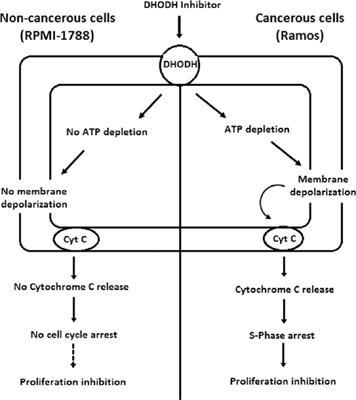Current Pharmaceutical Biotechnology ( IF 2.8 ) Pub Date : 2020-11-30 , DOI: 10.2174/1389201021666200611113734 Mohamad F A Kadir 1 , Shatrah Othman 1 , Kavitha Nellore 2

|
Background: The re-emerging of targeting Dihydroorotate Dehydrogenase (DHODH) in cancer treatment particularly Acute Myelogenous Leukemia (AML) has corroborated the substantial role of DHODH in cancer and received the attention of many pharmaceutical industries.
Objective: The effects of Brequinar Sodium (BQR) and 4SC-101 on lymphoblastoid cell lines were investigated.
Methods: DHODH expression and cell proliferation inhibition of lymphoblastoid and lymphoma cell lines were analyzed using Western blot analysis and XTT assay, respectively. JC-1 probe and ATP biochemiluminescence kit were used to evaluate the mitochondrial membrane potential and ATP generation in these cell lines. Furthermore, we explored the cell cycle progression using Muse™ Cell Cycle Kit.
Results: Ramos, SUDHL-1 and RPMI-1788 cells are fast-growing cells with equal expression of DHODH enzyme and sensitivity to DHODH inhibitors that showed that the inhibition of DHODH was not cancer-specific. In ATP depletion assay, the non-cancerous RPMI-1788 cells showed only a minor ATP reduction compared to Ramos and SUDHL-1 (cancer) cells. In the mechanistic impact of DHODH inhibitors on non-cancerous vs cancerous cells, the mitochondrial membrane potential assay revealed that significant depolarization and cytochrome c release occurred with DHODH inhibitors treatment in Ramos but not in the RPMI-1788 cells, indicating a different mechanism of proliferation inhibition in normal cells.
Conclusion: The findings of this study provide evidence that DHODH inhibitors perturb the proliferation of non-cancerous cells via a distinct mechanism compared to cancerous cells. These results may lead to strategies for overcoming the impact on non-cancerous cells during treatment with DHODH inhibitors, leading to a better therapeutic window in patients.
中文翻译:

二氢乳清酸脱氢酶抑制剂可促进细胞周期停滞并破坏拉莫斯细胞中的线粒体生物能。
背景:靶向二氢乳清酸脱氢酶(DHODH)在癌症治疗中,特别是急性骨髓性白血病(AML)的重新出现,证实了DHODH在癌症中的重要作用,并受到许多制药行业的关注。
目的:研究布雷喹钠(BQR)和4SC-101对淋巴母细胞系的影响。
方法:分别用蛋白质印迹分析和XTT分析法分析淋巴母细胞和淋巴瘤细胞系的DHODH表达和细胞增殖抑制作用。使用JC-1探针和ATP生物化学发光试剂盒来评估这些细胞系中的线粒体膜电位和ATP生成。此外,我们使用Muse™细胞周期试剂盒探索了细胞周期进程。
结果:Ramos,SUDHL-1和RPMI-1788细胞是快速生长的细胞,具有相同的DHODH酶表达,并且对DHODH抑制剂敏感,这表明DHODH的抑制作用不是癌症特异性的。在ATP耗竭试验中,与Ramos和SUDHL-1(癌细胞)相比,非癌性RPMI-1788细胞仅显示了较小的ATP降低。在DHODH抑制剂对非癌细胞与癌细胞的机制影响中,线粒体膜电位测定显示,DHODH抑制剂治疗在Ramos中发生了显着的去极化和细胞色素c释放,但在RPMI-1788细胞中却没有,表明增殖的机制不同抑制正常细胞。
结论:这项研究的发现提供了证据,与癌细胞相比,DHODH抑制剂通过一种独特的机制干扰了非癌细胞的增殖。这些结果可能导致克服DHODH抑制剂治疗期间对非癌细胞的影响的策略,从而为患者提供更好的治疗窗口。



























 京公网安备 11010802027423号
京公网安备 11010802027423号